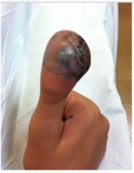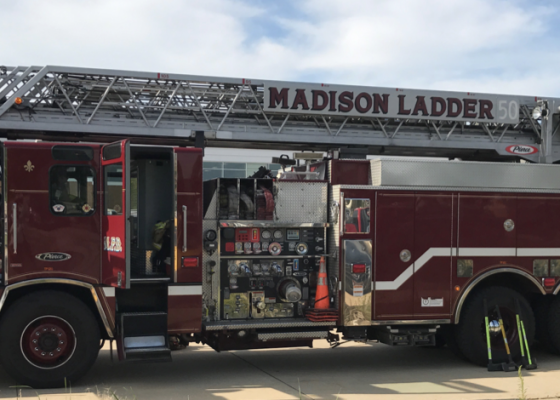Latest Articles
Rare Rapidly Growing Thumb Lesion in a 12-Year-Old Male
DOI: https://doi.org/10.21980/J8B92JHistory of present illness: A 12-year-old male presented to the emergency department with right thumb pain and a mass for four months (see images). He denied fevers, chills, change in appetite, or fatigue. He noted that the lesion was growing and “bleeds easily if bumped.” He denied any trauma to the thumb, except “hitting it” months ago while in football
Large Ventral Hernia
DOI: https://doi.org/10.21980/J86K9QComputed tomography (CT) scan with intravenous (IV) contrast of the abdomen and pelvis demonstrated a large pannus containing a ventral hernia with abdominal contents extending below the knees (white circle), elongation of mesenteric vessels to accommodate abdominal contents outside of the abdomen (white arrow) and air fluid levels (white arrow) indicating a small bowel obstruction.
Elderly female with acute abdominal pain presenting with Superior Mesenteric Artery Thrombus
DOI: https://doi.org/10.21980/J82W52Computed tomography (CT) angiogram of the abdomen and pelvis revealed a superior mesenteric artery (SMA) thrombosis 5 cm from the origin off of the abdominal aorta. As seen in the sagittal view, there does not appear to be any contrast 5 cm past the origin of the SMA. On the axial views, you can trace the SMA until the point that there is no longer any contrast visible which indicates the start of the thrombus. The SMA does not appear to be reconstituted. There was normal flow to the celiac artery. (See annotated images).
An OSCE Evaluation Tool for the Assessment of Emergency Medicine Resident Progression Performance of ACGME Patient Case and Interpersonal Communication Milestones
DOI: https://doi.org/10.21980/J8J63ROur goal was to create a standardized OSCE based formative assessment tool that could be deployed with minimal resource utilization. The purpose of our tool is to provide data regarding Emergency Medicine Residents’ performance in ACGME patient care milestones as they progress longitudinally through their residency.
A Model Curriculum for an Emergency Medical Services (EMS) Rotation for Emergency Medicine Residents
DOI: https://doi.org/10.21980/J8DD0FThe aim of this curriculum is to provide a robust learning experience for EM residents around prehospital care and EMS that fulfills the ACGME requirements and which can be easily replicated and implemented in a variety of EM residency training programs.
Hosting an eConference: Interactive video conference grand rounds between two institutions
DOI: https://doi.org/10.21980/J88P80Our objectives were to create and implement a novel virtual conference format through the integration of social media tools which allows for interdisciplinary and multi-site participation to enhance EM resident education. We wish to outline the steps required to reproduce this innovative session and share lessons learned.




